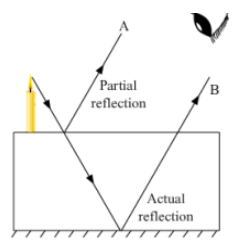
Answer
369k+ views
Hint: A plane mirror has a reflecting surface that is smooth (planar). The angle of reflection equals the angle of incidence for light rays striking a plane mirror. The angle of incidence is the angle formed by the incident ray and the normal of the surface (an imaginary line perpendicular to the surface).
Complete answer:
When a beam of light from a lit candle strikes the surface of a dense plane glass mirror, a small portion of the light (nearly 4% ) is reflected, creating a faint virtual image, while the majority of the light (nearly 96%) is refracted within the glass, forming a second image. The silvered surface within the glass now closely reflects this ray back.
This ray is then partly refracted in air, resulting in the formation of a new virtual image. Because of the intense reflection of light on the silver rim, this picture is the darkest.When we look at the reflection of a candle flame in a dense plane glass mirror, we see multiple dim images as well as one vivid one.
Partial reflection and partial refraction at the two surfaces of the glass plate or dense mirror cause this. And the strength of partly reflected light is lower than that of light that is actually reflecting at the plane mirror's surface. As a result, the second picture is the brightest.

Note: A plane mirror reflects objects in front of it, but these reflections tend to be behind the plane in which the mirror is located. A straight line drawn from one part of an object to the corresponding part of its image forms a right angle with the plane mirror's surface and is bisected by it. A plane mirror's reflection is often virtual (meaning the light rays do not originate from the image), upright, and the same shape and size as the object it is representing. A virtual image is a representation of an object produced at the position where light rays tend to originate.
Complete answer:
When a beam of light from a lit candle strikes the surface of a dense plane glass mirror, a small portion of the light (nearly 4% ) is reflected, creating a faint virtual image, while the majority of the light (nearly 96%) is refracted within the glass, forming a second image. The silvered surface within the glass now closely reflects this ray back.
This ray is then partly refracted in air, resulting in the formation of a new virtual image. Because of the intense reflection of light on the silver rim, this picture is the darkest.When we look at the reflection of a candle flame in a dense plane glass mirror, we see multiple dim images as well as one vivid one.
Partial reflection and partial refraction at the two surfaces of the glass plate or dense mirror cause this. And the strength of partly reflected light is lower than that of light that is actually reflecting at the plane mirror's surface. As a result, the second picture is the brightest.

Note: A plane mirror reflects objects in front of it, but these reflections tend to be behind the plane in which the mirror is located. A straight line drawn from one part of an object to the corresponding part of its image forms a right angle with the plane mirror's surface and is bisected by it. A plane mirror's reflection is often virtual (meaning the light rays do not originate from the image), upright, and the same shape and size as the object it is representing. A virtual image is a representation of an object produced at the position where light rays tend to originate.
Recently Updated Pages
How many sigma and pi bonds are present in HCequiv class 11 chemistry CBSE

Mark and label the given geoinformation on the outline class 11 social science CBSE

When people say No pun intended what does that mea class 8 english CBSE

Name the states which share their boundary with Indias class 9 social science CBSE

Give an account of the Northern Plains of India class 9 social science CBSE

Change the following sentences into negative and interrogative class 10 english CBSE

Trending doubts
Difference Between Plant Cell and Animal Cell

Fill the blanks with the suitable prepositions 1 The class 9 english CBSE

Difference between Prokaryotic cell and Eukaryotic class 11 biology CBSE

Differentiate between homogeneous and heterogeneous class 12 chemistry CBSE

Write a letter to the principal requesting him to grant class 10 english CBSE

Give 10 examples for herbs , shrubs , climbers , creepers

Write the differences between monocot plants and dicot class 11 biology CBSE

Change the following sentences into negative and interrogative class 10 english CBSE

Why is there a time difference of about 5 hours between class 10 social science CBSE



